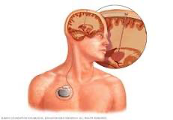Parkinson’s – Discussion Group and Education Series
August 24, 2022
Open Discussion
The conversation started with a question about Duopa, and then DBS. Most of the session was spent talking about various aspects of DBS.
Duopa Information – from sources listed below
What is a Duopa pump?
The “duopa pump,” FDA-approved in 2015 for advanced Parkinson’s disease, offers the alternative of bypassing the stomach and providing a steady drug infusion over 16 hours. The pump supplies carbidopa/levodopa combination therapy – a powerful tool in managing Parkinson’s disease symptoms since the mid 1970s.
How does Duopa pump work?
Duopa comes as a liquid suspension that’s in a cassette. The cassette attaches to a pump device that delivers the drug through a tube into your stomach over several hours. The stomach tube is often called a jejunal tube (J-tube). You or your caregiver will be trained on how to use Duopa with a pump.
More info here:
Although DBS became the focus, a few other were brought up. Patrick mentioned people who think they have bugs underneath their skin. They make a pill-boxing motion.
Mirapex– if taking it watch for side effects of OCD
Services available. Look to organizations like PCLA.org
Some of the better sites to browse for DBS Information
A snippet of each source is followed by its website
Ann gave a description of her procedure and others that have had DBS added to the conversation.
Patient satisfaction rates 92.5% were happy and 95% would recommend it
Medtronic
Cleveland
DBS and me
DBS Information
What are the risks of DBS surgery?

Side effects associated with deep brain stimulation may include:
- Seizure.
- Infection.
- Headache.
- Confusion.
- Difficulty concentrating.
- Stroke.
- Hardware complications, such as an eroded lead wire.
- Temporary pain and swelling at the implantation site.
Why it’s done
Deep brain stimulation is an established treatment for people with movement disorders, such as essential tremor, Parkinson’s disease and dystonia, and psychiatric conditions, such as obsessive-compulsive disorder. It’s also approved for use by the Food and Drug Administration to reduce seizures in difficult-to-treat epilepsy.
This treatment is reserved for people whose symptoms aren’t controlled with medications.
https://www.mayoclinic.org/tests-procedures/deep-brain-stimulation/about/pac-20384562
What is the downside to DBS?
These include the risk of bleeding, stroke, infection, and accumulating fluid in the brain. Also, since the brain is a complex and sensitive organ, it is possible for essential areas of the brain to get hurt during the procedure and cause additional symptoms unrelated to PD. May 31, 2017
https://parkinsonsdisease.net › clinical › deep-brain-stimul..
How common are DBS implantation procedures?
As of 2019, experts estimate that about 160,000 people have had a procedure to implant a DBS device since the 1980s. Experts also estimate that about 12,000 procedures happen each year.
https://my.clevelandclinic.org/health/treatments/21088-deep-brain-stimulation
What are the benefits?
- Symptom reduction: DBS often reduces symptoms significantly. These include motor symptoms like stiffness, tremor, slowness, and dyskinesia. DBS has also been shown to aid in on/off fluctuations, improve mood and quality of life, and increase overall energy level.
- Little to no damage: In contrast to previous methods, DBS does not damage portions of the brain, nor remove nerve cells.
- Decreased medication needs: Utilizing DBS in addition to levodopa could decrease a person’s need for medication, thus, decreasing medication access and cost issues, as well as levodopa side effects.
- Individualized treatment: Electrodes and stimulation frequency and intensity can be controlled by physicians and the individual with DBS and can be subjectively altered when needed.
https://parkinsonsdisease.net/clinical/deep-brain-stimulation-pros-cons





